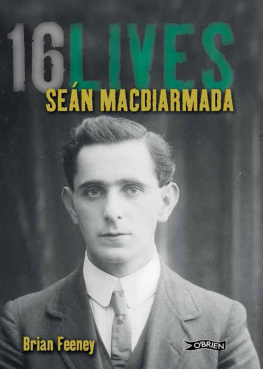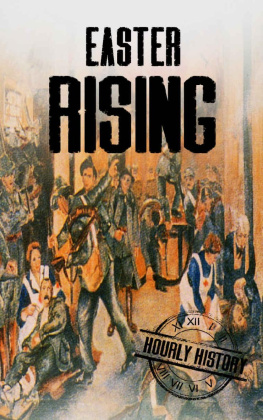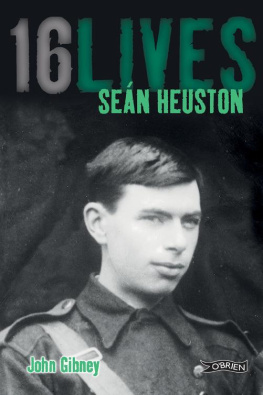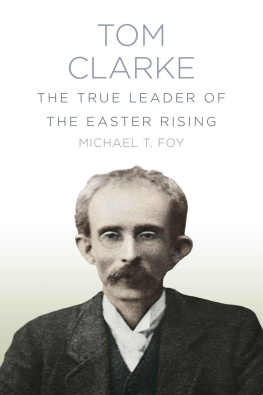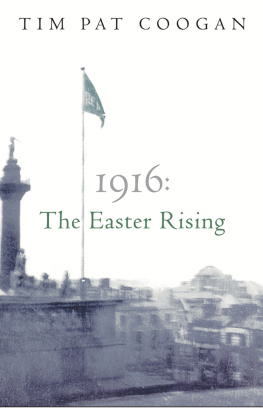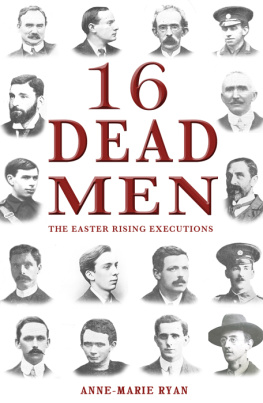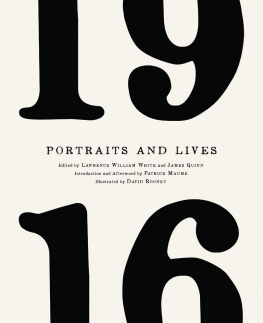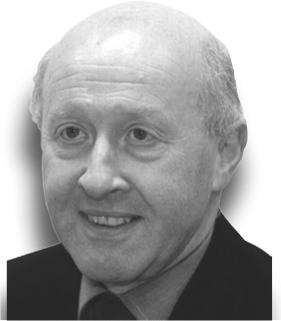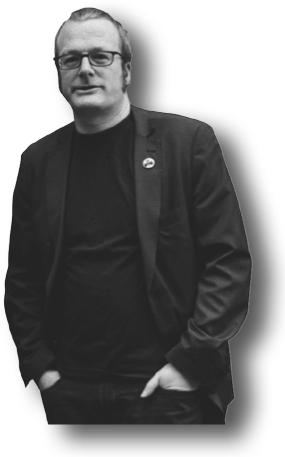The 16 LIVES Series
JAMES CONNOLLY Lorcan Collins
MICHAEL MALLIN Brian Hughes
JOSEPH PLUNKETT Honor O Brolchain
EDWARD DALY Helen Litton
SEN HEUSTON John Gibney
ROGER CASEMENT Angus Mitchell
SEN MACDIARMADA Brian Feeney
THOMAS CLARKE Helen Litton
AMONN CEANNT Mary Gallagher
JOHN MACBRIDE Donal Fallon
WILLIE PEARSE Roisn N Ghairbh
THOMAS MACDONAGH Shane Kenna
THOMAS KENT Meda Ryan
CON COLBERT John OCallaghan
MICHAEL OHANRAHAN Conor Kostick
PATRICK PEARSE Run ODonnell
BRIAN FEENEY AUTHOR OF 16LIVES: SEN MACDIARMADA
Brian Feeney is an historian and political commentator. As a writer, his work has received awards and critical acclaim. He is co-author of Lost Lives, the definitive work on all those who died as a result of the Troubles, and he is the author of the best-selling Sinn Fin, A Hundred Turbulent Years. A columnist for the Irish News, Brian is a respected commentator on Northern Irish politics. He lives in Belfast.
LORCAN COLLINS SERIES EDITOR
Lorcan Collins was born and raised in Dublin. A lifelong interest in Irish history led to the foundation of his hugely-popular 1916 Walking Tour in 1996. He co-authored The Easter Rising: A Guide to Dublin in 1916 (OBrien Press, 2000) with Conor Kostick. His biography of James Connolly was published in the 16 Lives series in 2012. He is also a regular contributor to radio, television and historical journals. 16 Lives is Lorcans concept and he is co-editor of the series.
DR RUN ODONNELL SERIES EDITOR
Dr Run ODonnell is a senior lecturer at the University of Limerick. A graduate of University College Dublin and the Australian National University, ODonnell has published extensively on Irish Republicanism. Titles include Robert Emmet and the Rising of 1803, The Impact of 1916 (editor), Special Category, The IRA in English prisons 19681978 and The OBrien Pocket History of the Irish Famine. He is a director of the Irish Manuscript Commission and a frequent contributor to the national and international media on the subject of Irish revolutionary history.
To my wife Patricia.
184551. The Great Hunger in Ireland. One million people die and over the next decades millions more emigrate.
1858, March 17. The Irish Republican Brotherhood, or Fenians , are formed with the express intention of overthrowing British rule in Ireland by whatever means necessary.
1867, February and March. Fenian Uprising.
1870, May. Home Rule movement founded by Isaac Butt, who had previously campaigned for amnesty for Fenian prisoners.
187981. The Land War. Violent agrarian agitation against English landlords.
1884, November 1. The Gaelic Athletic Association founded immediately infiltrated by the Irish Republican Brotherhood (IRB).
1893, July 31. Gaelic League founded by Douglas Hyde and Eoin MacNeill. The Gaelic Revival, a period of Irish Nationalism, pride in the language, history, culture and sport.
1900, September.Cumann na nGaedheal (Irish Council) founded by Arthur Griffith.
190507.Cumann na nGaedheal, the Dungannon Clubs and the National Council are amalgamated to form Sinn Fin (We Ourselves).
1909, August. Countess Markievicz and Bulmer Hobson organise nationalist youths into Na Fianna ireann (Warriors of Ireland ) a kind of boy scout brigade.
1912, April. Asquith introduces the Third Home Rule Bill to the British Parliament. Passed by the Commons and rejected by the Lords, the Bill would have to become law due to the Parliament Act. Home Rule expected to be introduced for Ireland by autumn 1914.
1913, January. Sir Edward Carson and James Craig set up Ulster Volunteer Force (UVF) with the intention of defending Ulster against Home Rule.
1913. Jim Larkin, founder of the Irish Transport and General Workers Union (ITGWU) calls for a workers strike for better pay and conditions.
1913, August 31. Jim Larkin speaks at a banned rally on Sackville (OConnell) Street; Bloody Sunday.
1913, November 23. James Connolly , Jack White and Jim Larkin establish the Irish Citizen Army (ICA) in order to protect strikers.
1913, November 25. The Irish Volunteers founded in Dublin to secure the rights and liberties common to all the people of Ireland.
1914, March 20. Resignations of British officers force British government not to use British army to enforce Home Rule, an event known as the Curragh Mutiny.
1914, April 2. In Dublin, Agnes OFarrelly, Mary MacSwiney, Countess Markievicz and others establish Cumann na mBan as a womens volunteer force dedicated to establishing Irish freedom and assisting the Irish Volunteers.
1914, April 24. A shipment of 35,000 rifles and five million rounds of ammunition is landed at Larne for the UVF.
1914, July 26. Irish Volunteers unload a shipment of 900 rifles and 45,000 rounds of ammunition shipped from Germany aboard Erskine Childers yacht, the Asgard. British troops fire on crowd on Bachelors Walk, Dublin. Three citizens are killed.
1914, August 4. Britain declares war on Germany. Home Rule for Ireland shelved for the duration of the First World War.
1914, September 9. Meeting held at Gaelic League headquarters between IRB and other extreme republicans. Initial decision made to stage an uprising while Britain is at war.
1914, September. 170,000 leave the Volunteers and form the National Volunteers or Redmondites . Only 11,000 remain as the Irish Volunteers under Ein MacNeill .
1915, MaySeptember. Military Council of the IRB is formed.
1915, August 1. Pearse gives fiery oration at the funeral of Jeremiah ODonovan Rossa.
1916, January 1922. James Connolly joins the IRB Military Council, thus ensuring that the ICA shall be involved in the Rising. Rising date confirmed for Easter.
1916, April 20, 4.15pm.The Aud arrives at Tralee Bay, laden with 20,000 German rifles for the Rising. Captain Karl Spindler waits in vain for a signal from shore.

